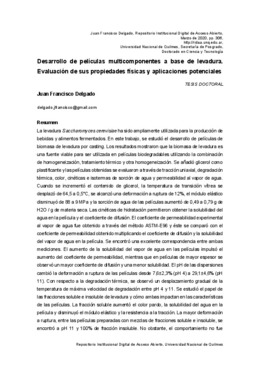Mostrar el registro sencillo del ítem
Desarrollo de películas multicomponentes a base de levadura. Evaluación de sus propiedades físicas y aplicaciones potenciales
| dc.creator | Delgado, Juan Francisco | |
| dc.date | 2021-04-13 | |
| dc.date.accessioned | 2021-04-16T18:22:05Z | |
| dc.date.available | 2021-04-16T18:22:05Z | |
| dc.date.issued | 2020-03-02 | |
| dc.identifier.citation | Delgado, J. F. (2021). Desarrollo de películas multicomponentes a base de levadura. Evaluación de sus propiedades físicas y aplicaciones potenciales. (Tesis de doctorado). Universidad Nacional de Quilmes, Bernal, Argentina. | es |
| dc.identifier.uri | http://ridaa.unq.edu.ar/handle/20.500.11807/2949 | |
| dc.description | Fil: Delgado, Juan Francisco. Universidad Nacional de Quilmes. Departamento de Ciencia y Tecnología. Laboratorio de Obtención, Modificación, Caracterización y Evaluación de Materiales; Argentina. | es |
| dc.description.abstract | La levadura Saccharomyces cerevisiae ha sido ampliamente utilizada para la producción de bebidas y alimentos fermentados. En este trabajo, se estudió el desarrollo de películas de biomasa de levadura por casting. Los resultados mostraron que la biomasa de levadura es una fuente viable para ser utilizada en películas biodegradables utilizando la combinación de homogeneización, tratamiento térmico y otra homogeneización. Se añadió glicerol como plastificante y las películas obtenidas se evaluaron a través de tracción uniaxial, degradación térmica, color, cinéticas e isotermas de sorción de agua y permeabilidad al vapor de agua. Cuando se incrementó el contenido de glicerol, la temperatura de transición vítrea se desplazó de 64,5 a 0,5°C, se alcanzó una deformación a ruptura de 12%, el módulo elástico disminuyó de 88 a 9 MPa y la sorción de agua de las películas aumentó de 0,49 a 0,79 g de H2O / g de materia seca. Las cinéticas de hidratación permitieron obtener la solubilidad del agua en la película y el coeficiente de difusión. El coeficiente de permeabilidad experimental al vapor de agua fue obtenido a través del método ASTM-E96 y éste se comparó con el coeficiente de permeabilidad obtenido multiplicando el coeficiente de difusión y la solubilidad del vapor de agua en la película. Se encontró una excelente correspondencia entre ambas mediciones. El aumento de la solubilidad del vapor de agua en las películas impulsó el aumento del coeficiente de permeabilidad, mientras que en películas de mayor espesor se observó un mayor coeficiente de difusión y una menor solubilidad. El pH de las dispersiones cambió la deformación a ruptura de las películas desde 7,6±2,3% (pH 4) a 29,1±4,6% (pH 11). Con respecto a la degradación térmica, se observó un desplazamiento gradual de la temperatura de máxima velocidad de degradación entre pH 4 y 11. Se estudió el papel de las fracciones soluble e insoluble de levadura y cómo ambas impactan en las características de las películas. La fracción soluble aumentó el color pardo, la solubilidad del agua en la película y disminuyó el módulo elástico y la resistencia a la tracción. La mayor deformación a ruptura, entre las películas preparadas con mezclas de fracciones soluble e insoluble, se encontró a pH 11 y 100% de fracción insoluble. No obstante, el comportamiento no fue superior al de una película preparada con la biomasa sin separar. Se estudió la incorporación de nanofibras de celulosa obtenidas a partir de cáscaras de arroz y de nanocelulosa de origen bacteriano, como refuerzo de la película, para mejorar las características mecánicas. La nanocelulosa bacteriana fue más efectiva e incrementó el módulo elástico, la resistencia a la tracción, la deformación y tenacidad a ruptura. Asimismo, se estudió la incorporación de timol para conferir a las películas características antioxidantes y se realizó una evaluación de su liberación en medios simulantes, obteniendo más de 80% de actividad antioxidante, medida en términos de % RSA (radical scavenging activity). Se exploró también la posibilidad de utilizar levadura residual cervecera y de procesar el material a través de moldeo por compresión. | es |
| dc.description.abstract | Saccharomyces cerevisiae yeast has been widely used for the production of fermented beverages and foods. In this work, the development of films by the casting method was studied through the combination of one or two high-pressure homogenizations and heat treatment of dispersions. The results showed that yeast biomass is a viable source for use in biodegradable films using the combination of homogenization, heat treatment, and a further homogenization. Glycerol was added as a plasticizer and films were evaluated using different techniques to analyse mechanical behaviour, thermal properties, colour, water sorption, and water vapour transport. When the glycerol content was increased, the glass transition temperature shifted from 64.5 to 0.5°C, the reached elongation at break was 12%, the elastic modulus decreased from 88 to 9 MPa and the water sorption of the films increased from 0.49 to 0.79 g of H2O/g of dry matter. Hydration kinetics allowed obtaining the solubility of water vapour in the film and the diffusion coefficient. When the glycerol content was increased, the water vapour solubility increased while the diffusion remained constant. The increase in film thickness decreased the water vapour solubility and increased the diffusion coefficient. Experimental water vapour permeability was obtained through the ASTM-E96 method and was compared with an alternative way to obtain the permeability coefficient, i.e., the product of the diffusion coefficient and the solubility coefficient of the water vapour in the film. Great correspondence between both methodologies was found. The increase in water vapour permeability of films, with the addition of glycerol, was due to increased water vapour solubility in the film matrix, while thicker films had a higher diffusion coefficient and a lower water vapour solubility. The pH of the dispersions modified the elongation at break of films from 7.6 ± 2.3% (pH 4) to 29.1 ± 4.6% (pH 11). Regarding the thermal degradation, a gradual shift of the maximum temperature of the degradation rate of films was observed between the minimum and maximum pH studied (4 to 11). Different assays were proposed to understand the changes promoted by pH in soluble and insoluble fractions of yeast biomass and how each fraction impacted on the characteristics of films. The soluble fraction increased the brown colour and solubility of the water vapor in the film, but decreased the elastic modulus and tensile strength. The highest elongation at break was found at pH 11 and 100% of the insoluble fraction. The addition of cellulose nanofibers from rice husks and bacterial nanocellulose was studied as film reinforcement to improve mechanical characteristics. In addition, thymol was incorporated in the films in order to give antioxidant characteristics to them, and an assessment of the release of thymol in different media was carried out. The possibility of using brewing residual yeast and processing the biomass by compression-molding were also explored. | en |
| dc.format | application/pdf | es |
| dc.format.extent | 306 p. | es |
| dc.language | spa | es |
| dc.publisher | Universidad Nacional de Quilmes | es |
| dc.rights | https://creativecommons.org/licenses/by-nc-nd/2.5/ar/ | es |
| dc.subject | Levaduras | es |
| dc.subject | Elaboración de alimentos | es |
| dc.subject | Propiedades físicas | es |
| dc.subject | Yeasts | en |
| dc.subject | Food processing | en |
| dc.subject | Physical properties | en |
| dc.subject | Leveduras | pt |
| dc.subject | Processamento de alimentos | pt |
| dc.subject | Propriedades físicas | pt |
| dc.title | Desarrollo de películas multicomponentes a base de levadura. Evaluación de sus propiedades físicas y aplicaciones potenciales | es |
| dc.type | info:ar-repo/semantics/tesis doctoral | es |
| unq.tesis.director | Wagner, Jorge Ricardo | |
| unq.tesis.codirector | Peltzer, Mercedes | |
| unq.tesis.calificacion | Aprobado-Sobresaliente | es |
| unq.tesis.titulo | Doctorado en Ciencia y Tecnología | es |
| unq.tesis.jurado | García, María Alejandra | |
| unq.tesis.jurado | Bertuzzi, María Alejandra | |
| unq.tesis.jurado | Bernal, Celina Raquel | |
| unq.version | info:eu-repo/semantics/acceptedVersion | en |
| unq.lugar.trabajo | Universidad Nacional de Quilmes. Departamento de Ciencia y Tecnología. Laboratorio de Obtención, Modificación, Caracterización y Evaluación de Materiales. | es |
| unq.tipo.snrd | info:eu-repo/semantics/doctoralThesis | en |
| unq.acceso | info:eu-repo/semantics/openAccess | en |
| unq.tesis.acta | 29 | es |
| unq.creador.correo | delgado.jfrancisco@gmail.com | es |
Ficheros en el ítem
Este ítem aparece en la(s) siguiente(s) colección(ones)
-
Tesis de posgrado
Tesis doctorales y de maestría

